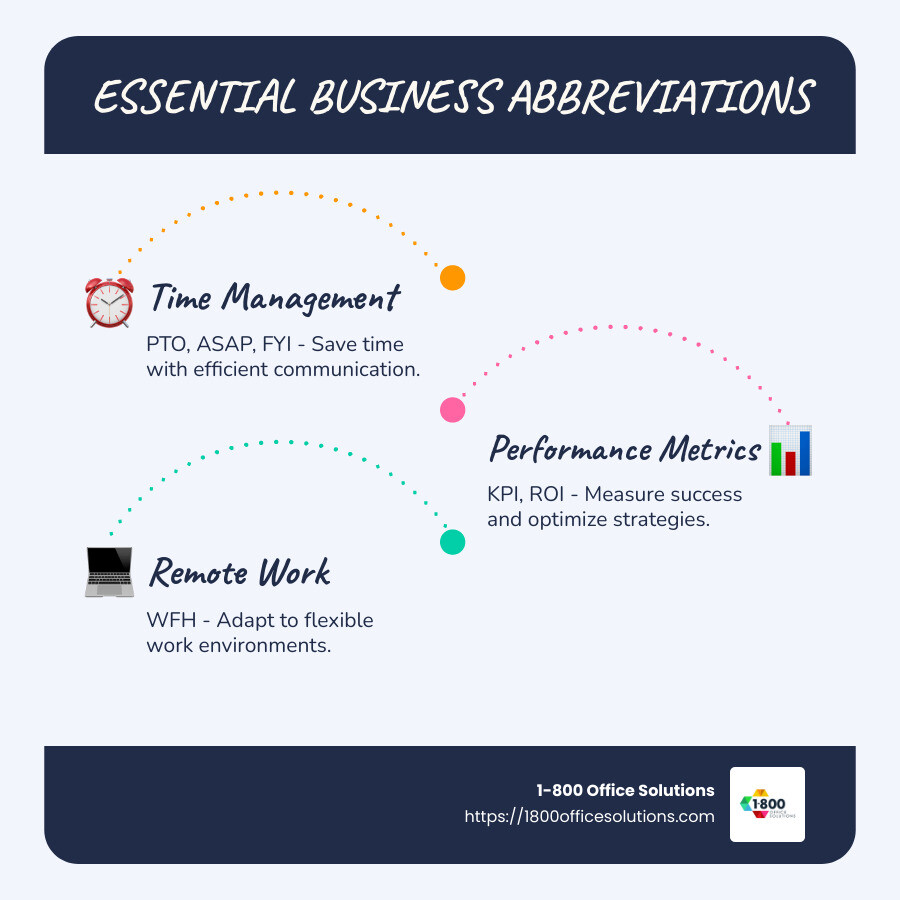10 Business Abbreviations You Need to Know Today
Common business abbreviations to know are vital for improving communication and boosting efficiency in today’s work environment. Here are some essential ones to quickly get you up to speed:
- PTO: Paid Time Off
- ROI: Return on Investment
- KPI: Key Performance Indicator
- ASAP: As Soon As Possible
- FYI: For Your Information
In business, every second counts, and using acronyms can save valuable time. They streamline conversations and clarify complex ideas swiftly. Whether you’re drafting an email or collaborating in a meeting, understanding these business abbreviations sharpens your communication and lifts team’s efficiency.

Basic Common business abbreviations to know vocab:
- 15 advantages and disadvantages of remote work
- 8 ways to improve your search engine ranking
- Windows 11 vs Windows 10: What are the differences
Common Business Abbreviations to Know
Understanding common business abbreviations is like having a secret code to open up faster and clearer communication at work. Here’s a closer look at a few key abbreviations that you should know today:
PTO (Paid Time Off)
PTO
is a crucial term in HR and employee management. It refers to the time employees are allowed to be away from work without losing pay. This can include vacation days, sick leave, and personal time. Knowing your PTO policy helps you plan your work-life balance effectively.
SMART (Specific, Measurable, Attainable, Realistic, Time-bound)
The SMART framework is a goal-setting tool used across industries to ensure that objectives are clear and reachable. Each letter stands for a criterion that helps in formulating effective goals. For example, a SMART goal might be: “Increase website traffic by 20% in the next three months.” This approach ensures that goals are well-defined and achievable within a set timeframe.
WFH (Work From Home)
The abbreviation WFH has gained prominence, especially in the wake of the COVID-19 pandemic. It refers to employees working remotely from their homes. Understanding WFH policies can help you steer the flexibility and challenges of remote work environments.
ROI (Return on Investment)
ROI
is a financial metric used to evaluate the efficiency of an investment. It measures the return relative to the investment cost. For example, if a marketing campaign costs $1,000 and generates $1,500 in revenue, the ROI would be 50%. This metric is crucial for decision-making and assessing the profitability of various business activities.
KPI (Key Performance Indicator)
KPIs
are measurable values that indicate how effectively a company is achieving its key business objectives. They vary across industries; in sales, a KPI might be the number of new customers acquired per month. Understanding KPIs helps teams focus on what matters most for the success of the business.
By familiarizing yourself with these common business abbreviations, you can improve your communication skills and contribute more effectively to your team. These terms are not just jargon—they’re tools that can help streamline processes and improve overall productivity.
General Business Abbreviations
Abbreviations like COB, EOD, ETA, FYI, and ASAP are used daily to keep communication swift and clear. Understanding these common business abbreviations can save you time and help you stay in sync with your team.
COB (Close of Business)
COB
refers to the end of the business day. It’s often used to set deadlines, like when a report is due by COB. Knowing this term helps ensure you’re on track with daily tasks and deadlines.
EOD (End of Day)
Similar to COB, EOD signifies the end of the working day but can sometimes be more flexible, depending on your company’s culture. When someone asks for an update by EOD, it means they expect it before you log off for the day.
ETA (Estimated Time of Arrival)
ETA
is used to predict when something will arrive or be completed. It’s crucial for project management and logistics. For example, if you’re waiting on a delivery, knowing the ETA helps you plan your tasks around it.
FYI (For Your Information)
FYI
is a polite way to share information that might be useful or relevant, without requiring any action. It’s often used in email subject lines to flag important details quickly.
ASAP (As Soon As Possible)
ASAP
conveys urgency. When something needs to be done ASAP, it should be your top priority. However, it’s always good to clarify what ASAP means in context, as urgency can vary.
By incorporating these abbreviations into your daily communication, you can improve understanding and efficiency in your work environment. These terms are not just shortcuts—they’re vital tools to keep everyone informed and aligned.
Financial Abbreviations
Common business abbreviations to know
can significantly improve communication and efficiency. Let’s explore some key financial abbreviations that are crucial for understanding financial statements and operations.
AP (Accounts Payable)
AP
represents the money a company owes to its suppliers or vendors for goods and services received. Managing AP efficiently is essential for maintaining good supplier relationships and ensuring liquidity. For instance, a company that delays AP might face supply chain disruptions.
AR (Accounts Receivable)
On the flip side, AR stands for money owed to a company by its customers. Keeping a close eye on AR helps businesses maintain cash flow and predict future revenues. Companies often use AR aging reports to track overdue payments and manage collections.
EPS
is a key indicator of a company’s profitability. It shows how much profit is allocated to each outstanding share of common stock. Investors often look at EPS to gauge a company’s financial health and to compare it with peers in the industry. A higher EPS generally indicates better performance.
FIFO (First-In, First-Out)
FIFO
is an inventory valuation method where the oldest inventory items are recorded as sold first. This approach matches the cost of goods sold with the actual flow of goods, especially in industries where products have a limited shelf life. Choosing FIFO can impact a company’s financial statements, particularly in periods of inflation.
P&L (Profit and Loss)
The P&L statement, also known as the income statement, provides a summary of a company’s revenues, costs, and expenses over a specific period. It’s a vital tool for assessing financial performance and making informed business decisions. Understanding the P&L helps stakeholders evaluate profitability and operational efficiency.

By grasping these financial abbreviations, you can better interpret financial reports and make informed decisions. These terms are not just jargon; they’re essential for navigating the financial aspects of a business.
Marketing and Sales Abbreviations
In marketing and sales, common business abbreviations to know can streamline communication and improve your team’s efficiency. Let’s explore some essential acronyms that are frequently used in these fields.
B2B (Business to Business)
B2B
refers to transactions or interactions between businesses. This model involves selling products or services from one business to another. Companies like 1-800 Office Solutions often engage in B2B sales, providing office solutions directly to other businesses. Understanding B2B dynamics is crucial for tailoring marketing strategies to meet the needs of business clients.
B2C (Business to Consumer)
On the other hand, B2C stands for business-to-consumer transactions. This model involves selling products or services directly to individual consumers. Think of online retailers like Amazon, which exemplify the B2C model by selling products directly to the end user. Marketing strategies in B2C often focus on emotional appeal and convenience to drive consumer purchases.
CRM (Customer Relationship Management)
CRM
systems are tools used by businesses to manage interactions with current and potential customers. A robust CRM platform helps track customer data, sales interactions, and service requests. By leveraging CRM, businesses can improve customer satisfaction, increase retention, and drive sales. For example, a company using CRM can personalize marketing campaigns based on customer preferences.
SEO (Search Engine Optimization)
SEO
is the process of improving a website’s visibility on search engines like Google. Good SEO practices ensure that a company’s website appears higher in search results, attracting more visitors and potential customers. For instance, optimizing content with relevant keywords can significantly boost a site’s ranking, bringing in organic traffic and leads.
CTA (Call to Action)
A CTA is a prompt on a website or advertisement that encourages users to take a specific action, such as “Buy Now” or “Sign Up.” Effective CTAs are crucial for guiding prospects through the sales funnel. They should be clear, compelling, and aligned with the overall marketing message to convert visitors into customers.
By mastering these marketing and sales abbreviations, you can better steer the landscape of business communication and strategy. These terms are more than just shorthand; they represent crucial concepts that drive successful marketing and sales efforts.
Technical and IT Abbreviations
Common business abbreviations to know
can significantly improve communication and efficiency. Let’s break down some essential tech acronyms you might encounter.
API (Application Programming Interface)
An API is a set of rules and protocols for building and interacting with software applications. It allows different software programs to communicate with each other, enabling integration and functionality expansion. For instance, when you use a travel app to book flights and hotels in one place, it’s likely using multiple APIs to pull information from various airlines and hotel chains.
CPU (Central Processing Unit)
The CPU is often referred to as the “brain” of a computer. It performs most of the processing inside a computer, executing instructions from programs. Whether you’re browsing the web or running complex algorithms, the CPU is hard at work behind the scenes, ensuring your commands are carried out efficiently.
HTML (Hypertext Markup Language)
HTML
is the standard language used to create and design web pages. It structures content, such as text, images, and links, on the internet. When you visit a website, the page layout and elements you see are crafted using HTML. It’s a fundamental technology for web development, working alongside CSS and JavaScript.
VPN (Virtual Private Network)
A VPN is a service that encrypts your internet connection, providing privacy and security by masking your IP address. It’s essential for protecting sensitive data, especially when using public Wi-Fi networks. Many businesses use VPNs to ensure secure remote access to their internal networks, safeguarding company information from cyber threats.
UX (User Experience)
UX
encompasses all aspects of a user’s interaction with a company, its services, and its products. Good UX design focuses on making products easy and enjoyable to use, enhancing customer satisfaction. For example, a well-designed mobile app with intuitive navigation and quick response times offers a positive user experience, encouraging continued use.
Understanding these technical and IT abbreviations is crucial for anyone working in or with the tech industry. They represent core concepts and technologies that drive today’s digital landscape, making them indispensable in effective business communication.
Frequently Asked Questions about Common Business Abbreviations to Know
What is the importance of business abbreviations?
Business abbreviations are like shortcuts in communication. They help convey information quickly and efficiently. Imagine you’re in a meeting, and someone says, “We need to increase our ROI.” Instead of explaining “Return on Investment” every time, using ROI saves time and keeps the conversation flowing.
Abbreviations also foster a shared understanding. When everyone knows the lingo, it reduces misunderstandings and keeps everyone on the same page. This is especially important in environments where decisions need to be made swiftly.
How can I learn business abbreviations quickly?
Learning business abbreviations doesn’t have to be daunting. Here are some tips to speed up the process:
- Resources: Use online glossaries and guides. Websites like MindTools and PerformYard offer detailed explanations of business acronyms.
- Practice: Incorporate abbreviations into your daily communication. The more you use them, the more familiar they become.
- Repetition: Repeated exposure is key. Write them down, make flashcards, or quiz yourself regularly.
By consistently engaging with these abbreviations, you’ll soon find them second nature.
Are business abbreviations industry-specific?
Yes and no. Some abbreviations, like ASAP (As Soon As Possible) and FYI (For Your Information), are universal and used across various industries. These are considered general abbreviations.
However, many abbreviations are industry-specific. For example, API (Application Programming Interface) is common in tech, while P&L (Profit and Loss) is used in finance. Despite this, there is often overlap. For instance, ROI is relevant in both marketing and finance.
Understanding which abbreviations are general versus industry-specific can improve your communication skills across different fields.
Conclusion
At 1-800 Office Solutions, we understand that effective communication is the backbone of any successful business. In today’s world, common business abbreviations play a crucial role in streamlining communication and boosting efficiency. By embracing these shortcuts, businesses can save time, reduce misunderstandings, and foster a shared understanding among team members.
Our commitment is to provide you with the best office solutions, ensuring that your communication tools and systems are up to date and efficient. Whether you’re looking to improve your team’s collaboration with unified communications or streamline project management with the latest technology, we have you covered.
Visit our best office solutions page to explore how we can help you optimize your office environment and improve communication efficiency.
Incorporating business abbreviations into your daily vocabulary isn’t just about keeping up with trends—it’s about enhancing clarity and productivity. As you continue to learn and use these abbreviations, you’ll find that they become second nature, allowing you to communicate more effectively and focus on what truly matters: growing your business.
By partnering with us, you’ll have access to the tools and expertise needed to steer the modern business landscape confidently. Let’s work together to make your office communication as efficient as possible.











